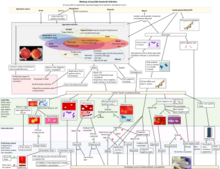Enterococcus
Enterococcus is a large
Physiology and classification
Enterococci are facultative anaerobic organisms, i.e., they are capable of cellular respiration in both oxygen-rich and oxygen-poor environments.[3] Though they are not capable of forming spores, enterococci are tolerant of a wide range of environmental conditions: extreme temperature (10–45 °C), pH (4.6–9.9), and high sodium chloride concentrations.[4]
Enterococci exhibit variable
History
Members of the genus Enterococcus (from Greek έντερο, éntero 'intestine' and κοκκος, coccos 'granule') were classified as group D Streptococcus until 1984, when genomic DNA analysis indicated a separate genus classification would be appropriate.[6]
Evolution
This genus appears to have evolved 425 million years ago to 500 million years ago.[7]
Pathology
Important clinical infections caused by Enterococcus include

Meningitis
Enterococcal meningitis is a rare complication of neurosurgery. It often requires treatment with intravenous or
Antibacterial resistance
From a medical standpoint, an important feature of this genus is the high level of
Bacillus haynesii CD223 and Advenella mimigardefordensis SM421 can inhibit the growth of Enterococcus spp. [20]
Water quality
In bodies of water, the acceptable level of contamination is very low; for example in the state of Hawaii, and most of the United States, the limit for water off its beaches is a five-week geometric mean of 35 colony-forming units per 100 ml of water, above which the state may post warnings to stay out of the ocean.[21] In 2004, measurement of enterococci took the place of fecal coliforms as the new American federal standard for water quality at public saltwater beaches and alongside Escherichia coli at freshwater beaches.[22] It is believed to provide a higher correlation than fecal coliform with many of the human pathogens often found in city sewage.[23]
References
- ^ LPSN).
- ^ ISBN 978-1-55581-234-8.
- ISBN 1-55581-166-3.
- ^ PMID 19383684.
- PMID 12791882.
- .
- PMID 28502769.
- ^ ISBN 0-8385-8529-9.
- PMID 29109849.
- PMID 21413321.
- PMID 11120989.
- S2CID 24189202.
- ^ "Enterococcus sp rRNA [Presence] in Specimen by Probe". Logical Observation Identifiers Names and Codes (LOINC). Regenstrief Institute, Inc. 5001-3.
- PMID 38075422.
- PMID 18371517.
- PMID 11572153.
- PMID 8460927.
- PMID 12019099.
- ^ "Enterococcus sp DNA [Presence] by NAA with probe detection in Positive blood culture". Logical Observation Identifiers Names and Codes (LOINC). Regenstrief Institute, Inc. 92784-8.
- PMID 36453920.
- ^ "Clean Water Branch" (PDF). Hawaii State Department of Health. Archived from the original (PDF) on 2011-11-11. Retrieved 2012-05-18.
- ^ "Water Quality Standards for Coastal and Great Lakes Recreation Waters; Final Rule". Federal Register. 69 (220): 67218–67243. 16 November 2004. Retrieved 26 November 2014.
- S2CID 35780753.

